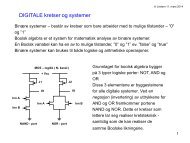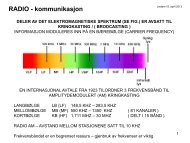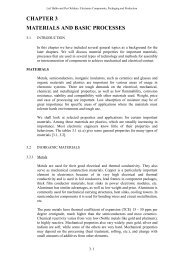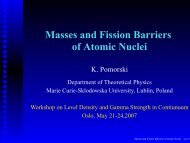Characterization of vacancy-type defects in silicon using deep level ...
Characterization of vacancy-type defects in silicon using deep level ...
Characterization of vacancy-type defects in silicon using deep level ...
You also want an ePaper? Increase the reach of your titles
YUMPU automatically turns print PDFs into web optimized ePapers that Google loves.
Figure 4. Visualization <strong>of</strong> the atomicstructure <strong>of</strong> the O i (a), VO (b) and V 2 (c)<strong>defects</strong>.Electron and charge states for V 2Figure 5. Illustration <strong>of</strong> electronstates and charge states for theV 2 centre <strong>in</strong> <strong>silicon</strong>.E C2--0.23 eV0.43 eV0E V+0.20 eVand it causes three different electron states <strong>in</strong> E g correspond<strong>in</strong>g to four charge states <strong>of</strong> V 2 (+,0, -1, -2), as depicted <strong>in</strong> Figure 5.I.(b) Emission and capture <strong>of</strong> electrons/holes by energy states <strong>in</strong> the band gapLet us consider an electron state at an energy E T below E c and with a concentration <strong>of</strong> N T .Figure 6(a) shows the total ‘traffic’ <strong>of</strong> electrons and holes to and from this state. The rate <strong>of</strong>emission <strong>of</strong> an electron to E c and a hole to E v are denoted by e n and e p , respectively. The rate<strong>of</strong> capture <strong>of</strong> an electron from E c or a hole from E v are nc n and pc p , respectively, where c n andc p are the so-called capture coefficients, and n and p are the concentrations <strong>of</strong> electrons <strong>in</strong> theconduction band and holes <strong>in</strong> the valence band, respectively.4














